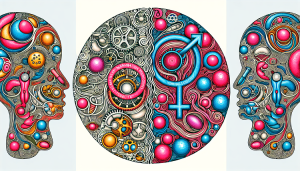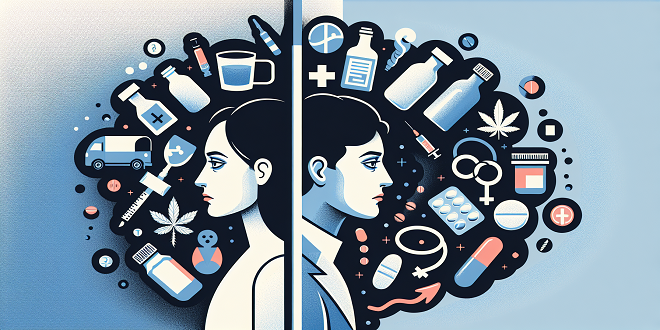Men and women face notably different battles when dealing with a substance abuse problem. Research reveals a gender gap: 11.5% of males struggle with such disorders compared to 6.4% of females. This article explores the nuanced reasons behind these gender differences in substance use disorders, examining biological, psychological, and social factors. Understanding these disparities is key to developing gender-specific treatment modalities.
Here, we dive into the intricacies of how men and women experience addiction differently and the crucial role gender plays in both the problem and its solutions.
Key Takeaways
- Men are more likely to abuse illicit drugs and alcohol, while women often use substances to self-medicate and due to trauma. The gap in substance abuse between genders is closing, requiring gender-specific treatment approaches.
- Biological differences, particularly hormonal effects like estrogen’s impact on dopamine, lead to differences in addiction patterns and treatment needs between men and women, with women potentially developing dependencies at lower doses.
- Psychological factors and societal stigma create barriers to treatment, with women facing additional challenges such as perceived judgment if pregnant and lack of childcare support. Gender-specific treatment programs offer tailored approaches and have shown benefits for long-term recovery.
Men and Women Use Drugs Differently.
Substance abuse presents a multifaceted challenge, differing with each person it impacts. When examined from a gender perspective, revealing trends appear. Typically, men are more likely to indulge in illicit drug use and alcohol abuse whereas women tend to turn towards substances for self-medication purposes. This places alcohol and drug abuse as significant issues that require immediate attention.
The distinct differences in how males and females engage with substance use highlight the importance of creating gender-specific treatment programs tailored specifically to address the individual needs of male and female clients respectively.
Prevalence of Drug and Alcohol Abuse among Men and Women
Traditionally, men have been more likely to engage in substance use than women. Indeed, an alarming 11.5% of males aged twelve and older suffer from a substance use disorder, while only 6.4% of their female counterparts do the same. It seems that this gap is narrowing as women increasingly consume alcohol and prescription opioids at higher rates—a clear indication that the dynamics of substance abuse are rapidly evolving.
Currently, women represent approximately one-third of those experiencing issues with alcohol consumption and nearly half when it comes to difficulties associated with other drugs’ usage.
Choice of Substance Varies Between Genders
Men and women exhibit distinct preferences when it comes to the types of substances they use, often shaped by differing motivations for engaging in substance use. Men tend toward the misuse of alcohol and other illicit drugs like opioids more frequently than women prefer to smoke marijuana and take prescription drugs. Women report that the influence of traumatic experiences, like sexual assault and abusive relationships is particularly significant in shaping substance use behaviors.
For instance, increased use of cannabis and other illicit drugs among women, particularly young women, has been linked to their greater exposure to a series of traumatic events throughout their lives. This should be considered when seeking treatment in gender specific programs.
Reasons for Drug Abuse
Exploring the underlying causes of substance use, it becomes clear that women are more likely to abuse substances to gain some relief from trauma, abuse, and managing difficult feelings lead many . Men, conversely, tend toward substance use in efforts to boost sociability and self-assurance. Societal influences along with hormonal reactions can compel women to misuse stimulants as a means of gaining more energy or pursuing weight reduction goals and balancing duties related to their families or careers.
Biological Factors Influencing Gender Differences

Biological factors, including levels of testosterone and estrogen, are critical in understanding substance abuse as they influence the impact of substances on men and women differently. For instance, it’s often observed that women tend to develop a dependence on substances at lower doses than men, highlighting the significance of these biological differences alongside societal and personal influences in substance misuse.
Hormonal Influences
Hormones, especially estrogen, play a key role in the biological variances observed in substance use. The ‘reward’ effects of dopamine related to stimulant substances are affected by estrogen, potentially causing women to develop addictions more quickly and consume higher doses compared to men.
Recognizing the effect that estrogen has on addiction could inform the creation of treatment plans in substance use disorder treatment that are better tailored for women and thus more effective.
Differences in Metabolism and Response to Substances
Hormonal variations, along with the body’s distinct metabolic reaction to substances, play a significant role in creating gender differences related to substance use disorders. Typically, women initiate their substance use at lesser doses than men but accelerate into addiction at a faster rate. This swift advancement leads to dire outcomes: between 1999 and 2016, opioid-related fatalities in women soared by 596%, which exceeded the rise of 312% seen among men.
Psychological Factors Shaping Gender Differences

Psychological elements contribute additional insight into the gender differences observed in substance abuse, alongside biological factors. Men commonly engage in substance use to boost their sociability and self-assurance, whereas women are more likely to begin misusing substances as a response to traumatic incidents or problematic relationships. Consequently, these diverse psychological motivations lead to distinct experiences regarding substance abuse, dependence, and rehabilitation for both men and women.
Trauma and Substance Use
Trauma, including sexual abuse and assault, has a considerable impact on women’s lives and is closely associated with the onset of substance use as well as sustained substance use disorders. It is important to acknowledge that:
- Sexual abuse and childhood trauma occur more commonly among women
- Such abuses tend to result in higher rates of psychological issues like depression, anxiety or Post Traumatic Stress Disorder (PTSD) for women than men
- These mental health outcomes can affect the patterns of substance use in women
The distressing experiences related to trauma are pivotal factors driving many woman to abuse alcohol and engage in prescription drug misuse. This often leads to emergency room admissions or results in fatal overdoses.
Mental Health Conditions
Mental health conditions frequently accompany substance abuse, and these comorbidities may vary based on gender. Compared to their male counterparts, women who struggle with substance use are more likely to also experience a range of psychological issues including panic attacks, anxiety disorders, mood disorders, posttraumatic stress disorder (PTSD), and eating disorders.
Conversely, men grappling with substance use problems tend to show elevated instances of antisocial personality disorders. These differences in physical manifestations of psychological issues further highlights the need for a gender specific treatment program when treating drug and alcohol abuse.
Coping Strategies
Patterns of substance use among men and women are impacted by their methods of managing stress and anxiety. Women, in an effort to control pain, have a higher tendency than men to misuse prescription opioids, even without having been prescribed them.
Conversely, societal influences like peer pressure tend to drive men towards substance use more often than women, with a heightened likelihood that they will become addicted.
Barriers to Treatment for Men and Women

Numerous obstacles frequently stand in the way of men and women obtaining assistance, even though there are treatments accessible. The stigma associated with substance use abuse, coupled with the apprehension about facing discrimination or being judged by healthcare providers and others within their community, can prevent people from seeking help for these issues.
Especially for women, concerns over potential social or legal consequences—such as those that may arise if they are expecting a child—as well as insufficient child care options can make them reluctant to pursue treatment for substance use problems.
1.) Stigma and Shame
The profound societal stigma associated with substance abuse significantly impedes the pursuit of treatment. Individuals are frequently deterred from seeking assistance due to fears of being branded an addict, along with feelings of shame and embarrassment.
Societal expectations that frown upon men showing vulnerability serve as additional obstacles for men in their quest for substance use disorder treatment.
2.) Economic Factors
Both men and women are faced with considerable systemic obstacles in obtaining treatment for substance abuse, including economic challenges like the steep expenses associated with such care. This issue of affordability may become even more pronounced when individuals lack insurance coverage, which can obstruct their pathway to receiving necessary treatment for substance abuse.
3.) Family Responsibilities
Individuals with family obligations may find it difficult to access substance abuse treatment services, as the possibility of losing their job while receiving care can create a financial hurdle. This is particularly pressing for those who are financially responsible for their families and require consistent earnings.
Specifically, women frequently have additional child care duties which can complicate their path toward overcoming substance abuse. It should be recognized that women tend to encounter distinctive obstacles throughout their pursuit of recovery due to these added responsibilities.
Benefits of Gender-Specific Treatment Programs

Considering the distinctive journeys men and women often face with addiction, treatment programs tailored to each gender have shown effectiveness in fostering sustained recovery. Such gender-specific treatment initiatives:
- Improve both the methodology of treatment as well as its results
- Provide a secure environment and encouragement among fellow participants
- Customize their strategies to accommodate the biological and societal variances that influence how addiction manifests and is overcome in men and women.
1.) Personalized Approach and Specialized Treatment Plans
Gender-specific treatment programs provide a tailored experience that caters to the physiological and emotional processing variances observed between men and women. As an example of gender specific treatment, women-only treatment programs offer a secure and nurturing atmosphere which concentrates on unique aspects like motherhood, career challenges, domestic roles, along with recovery hurdles particularly relevant to other women who have been subject to abuse. This approach guarantees that all individuals – both men and women – benefit from specialized therapy designed for their specific needs within this safe and supportive environment, thus making it more likely for them to complete treatment.
2.) Builds Trust and Bonding
In addiction recovery, the creation of trust and strong bonds is crucial, which is amplified within environments that offer gender-specific treatment. These settings afford clients same-sex living spaces where they can enjoy increased privacy and form close connections with their peers, thereby facilitating candid discussions about personal challenges without a sense of discomfort.
3.) Minimizing Distractions
A noteworthy benefit of environments tailored to specific genders lies in the diminished presence of distractions, notably sexual tension. This allows clients to concentrate more effectively on their recovery, thereby improving the overall emphasis on recuperative procedures.
Gender Specific Treatment is the Key to Successful Treatment
It is evident that we are approaching a transformative phase in the realm of addiction treatment, recognizing the distinct experiences of men and women. Their journeys to recovery diverge, influenced by varied patterns of substance use, as well as disparate biological and psychological factors, which shape their unique obstacles to obtaining treatment.
A study from the National Institute on Drug Abuse (NIDA) has indicated a closing gender gap in substance use disorders. This signals an urgent need for our strategies in addressing addiction treatment to advance concurrently.
In conclusion, tackling addiction requires a tailored approach that recognizes the intricate mix of biological, psychological, and societal factors influencing men’s and women’s individual journeys. Programs designed to treat men and women separately, offer customized strategies that foster trust, reduce distractions, and cater to distinct needs—a beacon of hope for more effective recovery paths to complete treatment. Henceforth, in our ongoing quest to overcome addiction challenges, it is both essential and absolutely vital to acknowledge and accommodate the differences between genders within addiction treatment programs.
Frequently Asked Questions
1.) What are the gender differences in substance abuse treatment?
There are noticeable differences between genders in the treatment of substance abuse. Women exhibit a higher incidence of mental health conditions, necessitating care for concurrent problems like depression and anxiety when dealing with substance abuse. Even though a greater number of men pursue treatment for these disorders, women more frequently seek help specifically for addiction to sedatives.
2.) What is substance abuse in psychology?
In psychology, substance abuse is characterized by the overindulgence in various substances like alcohol, tobacco, opioids among others, which results in negative outcomes including problems within social contexts, at work and encounters with legal complications. It denotes a persistent pattern of addictive behavior where the user continues to consume despite experiencing harmful consequences.
3.) What are the statistics for mental illness and substance abuse?
Approximately one-third of adults suffer from either mental illness or substance abuse, and nearly half (46%) of young adults between the ages of 18-25 are impacted by these issues. About half of those with severe mental health conditions also contend with challenges related to substance abuse.
4.) Which gender most commonly drives under the influence of drugs?
Over the past thirty years, there has been a noticeable increase in the number of women who report driving while under the influence of alcohol and drugs. Despite men still being more likely to drink alcohol and drive, as well as have alcohol-related accidents, this rising trend among women is particularly prominent in self-reported instances of impaired driving.
5.) What are the gender differences in drugs?
Pharmacokinetics and pharmacodynamics shape the gender differences observed in drug effects. Women often experience increased drug exposure and elevated plasma concentrations for numerous medications, resulting in a greater frequency of adverse drug reactions when compared to men.
 Isaiminia World Breaking News & Top Stories
Isaiminia World Breaking News & Top Stories




